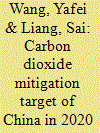|
|
|
Sort Order |
|
|
|
Items / Page
|
|
|
|
|
|
|
| Srl | Item |
| 1 |
ID:
122718


|
|
|
|
|
| Publication |
2013.
|
| Summary/Abstract |
China proposed a CO2 mitigation target in 2020 to deal with anthropogenic global climate change. Chinese policy makers mainly focus on three factors comprising consumption structure changes, energy technology development, and new energy increments. In addition, sectoral CO2 reduction is increasingly concerned in the world. Thus, it is significant to investigate integrated impacts of three factors to China's CO2 mitigation target as well as to identify key economic sectors for achieving this target. In this study, energy demand and CO2 emission in 2020 are predicted. Five scenarios are generated to illustrate the contributions of three factors. In addition, twelve key economic sectors for reducing energy demand and CO2 emission are identified from both production and final demand perspectives. Under integrated impacts of three factors, China's CO2 intensity per unit gross domestic product in 2020 will decrease by about 43.9% in 2020 than 2005 level. In the short term, China's CO2 mitigation will be highly dependent on energy technology development. In the long term, it will mainly rely on reshaped consumption structure changes and new energy development. In addition, China's future policies should focus on 12 identified key economic sectors.
|
|
|
|
|
|
|
|
|
|
|
|
|
|
|
|
| 2 |
ID:
104973


|
|
|
|
|
| Publication |
2011.
|
| Summary/Abstract |
Managing urban energy system is vital for energy conservation and CO2 reduction. Integrating energy input-output model with carbon emission pinch analysis, we propose a framework for managing urban energy system. This framework could analyze current energy demands and CO2 emissions, predict their future possibilities and optimize energy mix of key sectors under CO2 emission constraints. Key sectors are identified by the energy input-output table from both direct and accumulative perspectives. Moreover, taking Suzhou, a typical manufacturing center and export-oriented city in China, as a case example, energy metabolism of Suzhou in 2020 is predicted using energy input-output model. And three sectors named Coking, Smelting and pressing of metals and Production and supply of electric power are identified to have big effects on CO2 emissions. Subsequently, energy mix of three identified key sectors is optimized under CO2 emission constraints by the carbon emission pinch analysis. According to the results, clean energy sources will occupy a great position in Suzhou's future energy demands. And the reuse of wastes as energy sources should be limited to achieve CO2 mitigation targets. Finally, policy implications of results and future work are discussed.
|
|
|
|
|
|
|
|
|
|
|
|
|
|
|
|
| 3 |
ID:
128411


|
|
|
|
|
| Publication |
2014.
|
| Summary/Abstract |
The decline of China's energy intensity slowed since 2000. During 2002-2005 it actually increased, reversing the long-term trend. Therefore, it is important to identify drivers of the fluctuation of energy intensity. We use input-output structural decomposition analysis to investigate the contributions of changes in energy mix, sectoral energy efficiency, production structure, final demand structure, and final demand category composition to China's energy intensity fluctuation during 1997-2007. We include household energy consumption in the study by closing the input-output model with respect to households. Results show that sectoral energy efficiency improvements contribute the most to the energy intensity decline during 1997-2007. The increase in China's energy intensity during 2002-2007 is instead explained by changes in final demand composition and production structure. Changes in final demand composition are mainly due to increasing share of exports, while changes in production structure mainly arise from the shift of Chinese economy to more energy-intensive industries. Changes in energy mix and final demand structure contribute little to China's energy intensity fluctuation. From the consumption perspective, growing exports of energy-intensive products and increasing infrastructure demands explain the majority of energy intensity increase during 2002-2007.
|
|
|
|
|
|
|
|
|
|
|
|
|
|
|
|
| 4 |
ID:
110383


|
|
|
|
|
| Publication |
2011.
|
| Summary/Abstract |
Investigating CO2 emissions of China's manufacturing centers contributes to local and global CO2 mitigation targets. This study considers Jiangsu Province as a representation of manufacturing centers in South China. Effects of material efficiency improvements, technology development, consumption structure changes and consumption volume growth in Jiangsu Province on its CO2 emissions during 1997-2007 are investigated using structural decomposition analysis based on environmental input-output table. In order to reduce CO2 emissions, Jiangsu Province should not only rely on material efficiency improvements and technology development, but also rely on consumption structure changes. For consumption structure changes in detail, Jiangsu Province should not only focus on fixed capital formation and urban residential consumption, but also focus on international and intranational imports and exports. For the implementation of material efficiency improvements and technology development, Jiangsu Province should focus on technology innovation and international technology transfer. For the implementation of consumption structure changes, Jiangsu Province should mainly focus on identified sectors for each separate final demand category: five sectors for urban residential consumption, three sectors for fixed capital formation, four sectors for international exports, five sectors for intranational exports, three sectors for international imports and four sectors for intranational imports.
|
|
|
|
|
|
|
|
|
|
|
|
|
|
|
|
|
|
|
|
|